In this Section:
Book of Joshua | Book of Judges | Book of Ruth
Books of 1 Samuel & 2 Samuel | Books of 1 & 2 Kings | Books of 1 & 2 Chronicles
Book of Ezra | Book of Nehemiah | Book of Esther
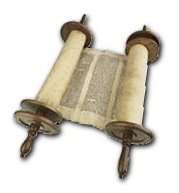 The next group of Old Testament books we will survey are the books of history. These include: The next group of Old Testament books we will survey are the books of history. These include:
- Joshua
Details how Moses' successor, Joshua, led the people of Israel into the Promised Land of Canaan. It records the military campaigns and the division of the land among the people.
- Judges
Israel turned away from God after Joshua's death. This book records the sad story of their repeated sins and the judges God raised up to deliver them from enemy forces.
- Ruth
This book tells the story of Ruth, a woman of the Gentile nation of Moab, who chose to stay with her mother-in-law and serve the God of Israel. She became the great grandmother of David.
- 1 Samuel
This book centers on three persons: Samuel who was the last of the judges of Israel; Saul, the first king of Israel; and David who succeeded a disobedient Saul as king.
- 2 Samuel
This book records the forty-year reign of King David.
- 1 Kings
This book details King Solomon's reign and the reigns of the kings of the divided kingdom through the reigns of Ahab in the north and Jehoshaphat in the south.
- 2 Kings
This book details the final decline of Israel and Judah.
- 1 Chronicles
This book records the reign of David and preparations for building the temple. The time period of this book parallels that of 2 Samuel.
- 2 Chronicles
This book continues Israel's history through Solomon's reign with focus on the southern kingdom. It closes with the decree of Cyrus, which permitted Israel's return to Jerusalem from Babylonian captivity.
- Ezra
This book also details the return of the Jews from Babylonian captivity to Jerusalem.
- Nehemiah
This book documents the rebuilding of Jerusalem's walls under Nehemiah. This project was begun about 14 years after Ezra returned with the people.
- Esther
This book tells of God's deliverance of the Jews through Queen Esther and her uncle Mordecai.
[Back to Top...]
Survey of the Book of Joshua
AUTHOR: Joshua
TO WHOM: Israel
PURPOSE: Record the history of the conquest of Canaan
KEY VERSE: 24:15— "And if it is evil in your eyes to serve the LORD, choose this day whom you will serve, whether the gods your fathers served in the region beyond the River, or the gods of the Amorites in whose land you dwell. But as for me and my house, we will serve the LORD."
LIFE AND MINISTRY PRINCIPLE: No moral or spiritual victories are won without battles.
MAIN CHARACTERS: Joshua, Rahab, Caleb, Achan, Balaam, Eleazar
Outline
- Entering the land: 1:1-5:15
- Joshua commissioned: 1:1-9
- Preparation to cross the Jordan: 1:10-2:24
- Jordan crossed: 3:1-4:24
- Gilgal occupied: 5:1-15
Possessing the land: 6:1-12:24
- Jericho and Ai taken: 6:1-8:29
- Joshua's altar: 8:30-35
- The Gibeonites received: 9:1-27
- Southern Canaan conquered: 10:1-43
- Northern Canaan conquered: 11:1-15
- The conquest summarized: 11:16-12:24
Occupying the land: 13:1-22:34
- Joshua instructed: 13:1-7
- The eastern tribes assigned: 13:8-33
- The western tribes assigned: 14:1-19:51
- The cities of refuge: 20:1-9
- Levitical towns: 21:1-45
- Eastern tribes sent home: 22:1-34
Joshua's farewell address and death: 23:1-24:33
- He reminds them of God's goodness: 23:3-10
- He warns them concerning disobedience: 23:11-13
- He reviews this history: 24:1-13
- He challenges them to serve God: 24:14-18
- He completes the book that bears his name: 24:26-28
- He dies and departs for Heaven: 24:29-33
[Back to Top...]
Survey of the Book of Judges
AUTHOR: Samuel
TO WHOM: Israel
PURPOSE: Historical record of the rule of the judges which occurred after the close of the book of
Joshua
KEY VERSE: 17:6— "In those days there was no king in Israel. Everyone did what was right in his own eyes."
LIFE AND MINISTRY PRINCIPLE: There is a divine pattern of chastisement designed to turn God's people from sin to salvation.
MAIN CHARACTERS: The judges (See list in outline below)
Outline
- Introduction to the period of the judges: 1:1-2:5
- Political conditions from Joshua to the time of the judges: 1:1-36
- Religious conditions from Joshua to the time of the judges: 2:1-5
The period of the judges: 2:6-16:31
- Summary of religious conditions of the entire period: 2:6-3:6
- List of the judges: 3:7-16:31
Historical appendix: 17:1-21:25
- The idolatry of Micah and the Danites: 17:1-18:31
- The crime of Benjamin at Gibeah and its punishment: 19:1-21:25
Further Study
The book of Judges is a complete contrast to the book of Joshua.
- Joshua tells of victory, freedom, faith, progress, obedience, spiritual vision, joy, strength, and unity among the tribes with strong leadership.
- Judges describes defeat, slavery, unbelief, division, disobedience, earthly emphasis, sorrow, weakness, and disunity among the tribes.
Galatians provides an excellent summary of the books of Joshua and Judges. For example, Galatians 5:22-26 describes Joshua: "But the fruit of the Spirit is love, joy, peace, patience, kindness, goodness, faithfulness, gentleness, self-control; against such things there is no law. And those who belong to Christ Jesus have crucified the flesh with its passions and desires. If we live by the Spirit, let us also walk by the Spirit. Let us not become conceited, provoking one another, envying one another."
And Galatians 5:17-21 describes Judges: "For the desires of the flesh are against the Spirit, and the desires of the Spirit are against the flesh, for these are opposed to each other, to keep you from doing the things you want to do. But if you are led by the Spirit, you are not under the law. Now the works of the flesh are evident: sexual immorality, impurity, sensuality, idolatry, sorcery, enmity, strife, jealousy, fits of anger, rivalries, dissensions, divisions, envy, drunkenness, orgies, and things like these. I warn you, as I warned you before, that those who do such things will not inherit the kingdom of God."
- Judges is a classic example of Hosea 8:7 and Galatians 6:7.
- Judges 17:6 summarizes the conditions that existed in Israel during the period of the Judges.
- Judges 15 tells us the story of the strongest man in history.
- Judges 12 tells us about an army that was put to death for mispronouncing a word.
- God used unusual methods in the book of Judges. He used:
- An ox goad: 3:31—
- A nail: 4:21—
- Trumpets: 7:20—
- Pitchers: 7:20—
- Lamps: 7:20—
- A millstone: 9:53—
- A jawbone of an ass: 15:15—
The Cycles of Judges
As you read through Judges, you can't help but notice the oft-recurring cycles. In the blank spaces below, notate the Scriptures that coincide with the actions. You may want to just check the boxes that apply to each set of verses, or you may want to write some detail about each. One cycle is already completed as an example for you to follow:

The Judges of Israel
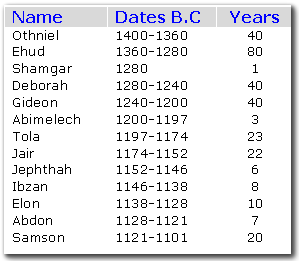
[Back to Top...]
Survey of the Book of Ruth
AUTHOR: Unknown
TO WHOM: Israel
PURPOSE: Written as part of the historical record of Israel to illustrate the concern of God for all people. Boaz's actions as the kinsman-redeemer for Ruth also illustrates the kinsman-redeemer relationship of Jesus Christ.
KEY VERSES: 1:16-17— "But Ruth said, 'Do not urge me to leave you or to return from following you. For where you go I will go, and where you lodge I will lodge. Your people shall be my people, and your God my God. Where you die I will die, and there will I be buried. May the LORD do so to me and more also if anything but death parts me from you.'"
LIFE AND MINISTRY PRINCIPLE: God can turn bitterness to blessing.
MAIN CHARACTERS: Naomi (Mara), Elimelech, Mahlon, Chilion, Orpha, Ruth, Boaz, unnamed kinsman
Outline
- Moab: 1:1-5
- Journey to Moab: 1:1-2
- Tragedy in Moab: 1:3-5
Return to Bethlehem: 1:6-18
- Naomi tells daughters-in-law to return to their own people: 1:6-9
- Their appeal to stay: 1:10
- Naomi's answer: 1:11-13
- Their response: 1:14
- Ruth's declaration: 1:16-18
Arrival in Bethlehem: 1:19-22
- Reception by the city: 1:19
- Naomi's response: 1:20-21
- The timing of the return: 1:22
Ruth in the fields of Boaz: 2:1-17
- Gleaning in the fields: 2:1-3
- Boaz's recognition: 2:4-13
- Mealtime with Boaz: 2:14
- Gleaning the best: 2:15-17
- Return from the fields: 2:18-23
A special plan: 3:1-18
- Naomi's plan: 3:1-5
- The results: 3:6-15
- The return to Naomi: 3:16-18
The redemption: 4:1-13
- The process: 4:1-12
- The union of Ruth and Boaz: 4:13-17
- The blessing: 4:14-16
The genealogy of David: 4:17-22
Further Study
For further background on the period during which the events of the book of Ruth occurred, go back to the book of Judges.
Ruth was one of four women mentioned in the genealogy of Christ in Matthew 1. The others are Tamar (Matthew 1:3), Rahab (1:5), and Bathsheba (1:6).
The obligations of the near kinsman's duties are outlined in Deuteronomy 25:5-10. The property laws with which the unnamed kinsman was concerned are given in Leviticus 25:23. The kinsman who was able to redeem had to meet certain requirements:
- He must be a near kinsman.
- He must be willing to redeem.
- He must have the ability to redeem.
- He must be free himself.
- He must have the price of redemption.
Boaz met all of these requirements for Ruth; and Jesus met all of these requirements as the Redeemer of sinful humanity.
Study the character of Ruth and notice the following character traits of this humble and committed young woman.
- Loving, committed: 1:16-17
- Steadfast: 1:18
- Humble: 2:2
- Temperate: 2:14
- Accountable: 2:18-19
- Faithful: 2:23
- Submissive: 3:10
- Focus on eternal values: 3:10
- Concerned about appearance of evil: 3:14
- Patient: 3:18
[Back to Top...]
Survey of the Book of 1 Samuel
1 Samuel
AUTHOR: Samuel
TO WHOM: Israel
PURPOSE: Continued record of God's dealing with His people
KEY VERSES: 15:22-23— "And Samuel said, 'Has the LORD as great delight in burnt offerings and sacrifices, as in obeying the voice of the LORD? Behold, to obey is better than sacrifice, and to listen than the fat of rams. For rebellion is as the sin of divination, and presumption is as iniquity and idolatry. Because you have rejected the word of the LORD, he has also rejected you from being king.'"
LIFE AND MINISTRY PRINCIPLE: Obedience to God is more important than sacrifice.
MAIN CHARACTERS: Samuel, Saul, Elkanah, Hannah, Eli, David, Goliath, Jonathan, Michal, Abigail
Outline
- Samuel: The last of the judges: 1:1-7:17
- Samuel's birth and childhood: 1:1-2:10
- Eli's rejection and Samuel's call: 2:11-3:21
- The ark among the Philistines: 4:1-7:1
- Samuel's activities as judge: 7:2-17
Saul: The first of the kings: 8:1-15:35
- Israel's demand for a king: 8:1-22
- The choice of Saul: 9:1-11:15
- Samuel's farewell address: 12:1-25
- Saul's war against the Philistines: 13:1-14:52
- Saul's disobedience and rejection: 15:1-35
Saul and David: 16:1-31:13
- David's anointing and call: 16:1-23
- David's victory over Goliath: 17:1-58
- David's flight from Saul: 18:1-20:42
- David's wanderings: 21:1-30:31
- Saul's death: 31:1-13
Further Study
1 Samuel records a transition in Israel from a theocracy [where God ruled directly through priests and military leaders] to a monarchy [the rule by various kings].
1 Samuel is more than just a history lesson; it's a treasure trove of excellent passages and lessons, too. For example...
- For a great passage on obedience vs. ritual, look at 1 Samuel 15:22-23a. "And Samuel said, 'Has the LORD as great delight in burnt offerings and sacrifices, as in obeying the voice of the LORD? Behold, to obey is better than sacrifice, and to listen than the fat of rams. For rebellion is as the sin of divination, and presumption is as iniquity and idolatry.'"
- 1 Samuel 16:7 is one of the greatest passages on true human worth. "But the LORD said to Samuel, 'Do not look on his appearance or on the height of his stature, because I have rejected him. For the LORD sees not as man sees: man looks on the outward appearance, but the LORD looks on the heart.'"
- 1 Samuel 18:1 records one of the most beautiful friendships recorded in the Bible. "As soon as he had finished speaking to Saul, the soul of Jonathan was knit to the soul of David, and Jonathan loved him as his own soul."
- 1 Samuel also records the first of several conversations of people who had previously left this earth in death. (See 1 Samuel 28; Luke 16:23-31; Revelation 6:9-10 and 7:9-10.)
Samuel started the first Bible schools recorded in Scripture. They were located at Gilgal, Jericho, and Bethel. (See 1 Samuel 10:10; 1 Kings 18:13; 2 Kings 2:3,5; 6:1-2.)
[Back to Top...]
Survey of the Book of 2 Samuel
AUTHOR: Samuel
TO WHOM: Israel
PURPOSE: Continue the historical record of God's dealing with His people.
KEY VERSES: 7:22-23— "Therefore you are great, O LORD God. For there is none like you, and there is no God besides you, according to all that we have heard with our ears. And who is like your people Israel, the one nation on earth whom God went to redeem to be his people, making himself a name and doing for them great and awesome things by driving out before your people, whom you redeemed for yourself from Egypt, a nation and its gods?"
LIFE AND MINISTRY PRINCIPLE: God carries out His plan through those obedient to Him in spite of their human weaknesses.
MAIN CHARACTERS: David, Uriah, Bathsheba, Nathan, Absalom, Abner, Isbosheth, Joab
Outline
- The triumphs of David: 1:1-10:19
- The lament of David over Saul and Jonathan: 1:1-27
- David's coronation over Judah: 2:1-7
- David establishes national and religious unity: 2:8-6:23
- The Davidic covenant: 7:1-29
- David's conquests: 8:1-10:19
The troubles of David: 11:1-24:25
- David's sin and repentance: 11:1-12:31
- Amnon and Absalom's crimes: 13:1-18:33
- David's restoration to power: 19:1-20:26
- The famine and revenge of the Gibeonites: 21:1-14
- Heroes in the war with the Philistines: 21:15-22
- David's song and last words: 22:1-23:7
- David's heroes: 23:8-39
- David's census and punishment: 24:1-25
Further Study
2 Samuel records an important law of sowing and reaping in the spiritual world. After David's prayer of repentance in Psalm 51, God forgave him for adultery and murder (cf. 2 Samuel 11). However, David still harvested sorrow from his actions. The harvest involved:
- the death of an infant son (cf. 2 Samuel 12:9-18);
- the rape of a daughter by her own brother (cf. 2 Samuel 13:1-14);
- the murder of that brother by another brother (cf. 2 Samuel 13:28-29); and
- the rebellion of his favorite son who was later executed by a military commander(cf. 2 Samuel 18:9-14).
Another important principle is taught in 2 Samuel. It is the principle of doing God's will God's way. It was God's will for David to bring the ark into the Holy City. God's way was for the priests to carry it. At first, David did not obey and it resulted in sorrow and death (cf. 6:1-7). It is important to harmonize God's will with God's ways.
[Back to Top...]
Survey of the Books of 1 and 2 Kings
1 Kings
AUTHOR: Unknown. Possibly Jeremiah.
TO WHOM: Israel
PURPOSE: Continue the record of God's dealings with His people, Israel.
KEY VERSE: 19:18— "Yet I will leave seven thousand in Israel, all the knees that have not bowed to Baal, and every mouth that has not kissed him."
LIFE AND MINISTRY PRINCIPLE: Compromise may seem easy, but it is always costly later.
MAIN CHARACTERS: David, Solomon, kings of Judah and Israel (see the charts on the kings), Nabath, Ahab, Elijah, and Elisha
Outline
- The reign of King Solomon: 1:1-11:43
- His anointing as king: 1:1-53
- David's challenge to Solomon and the death of David: 2:1-46
- Solomon's marriage and choice of wisdom: 3:1-28
- Building activities of Solomon: 5:1-8:66
- The wealth and splendor of Solomon: 9:1-10:29
- Solomon's sin: 11:1-43
The reigns of the kings of Judah and Israel: 12:1-22:53
[Continues into 2 Kings. (See the charts on the kings of Isreal and of Judah)]
- Accession to the throne of Rehoboam: 12:1-33
- Judah's kings: Rehoboam to Jehoshaphat: 13:1-22:53
- Israel's kings: Jeroboam to Ahaziah: 13:1-22:53
- Ministry of the Prophet Elijah to Israel: 17:1-22:53
2 Kings
AUTHOR: Unknown. Possibly Jeremiah.
TO WHOM: Israel
PURPOSE: Continue the record of God's dealings with His people, Israel.
KEY VERSE: 2:9-10— "When they had crossed, Elijah said to Elisha, 'Ask what I shall do for you, before I am taken from you.' And Elisha said, 'Please let there be a double portion of your spirit on me.' And he said, 'You have asked a hard thing; yet, if you see me as I am being taken from you, it shall be so for you, but if you do not see me, it shall not be so.'"
LIFE AND MINISTRY PRINCIPLE: Kingdoms of this world are temporal: They rise and fall under God's control.
MAIN CHARACTERS: Kings of Israel and Judah (see chart on the kings), Elisha, Elijah
Outline
- Ministry of Elisha and continuing record of the kings of Israel: 1:1-10:36
Record of the kings of Israel and Judah: 11:1-17:41 continued from the I Kings record (see chart of the kings below).
Reigns of Judah's kings: Hezekiah to Zedekiah: 18:1-25:30 (see the charts on the kings).
Further Study
Chapter 12 of 1 Kings records the disintegration of Israel's 12 tribes. Revelation 7 describes the future uniting of these tribes. The chart in this section summarizes information on the divided kingdoms of Israel and Judah. The map shows the territorial division.
King Solomon, a main character in the book of 1 Kings, wrote Proverbs, Ecclesiastes, and the Song of Solomon. You will study these books later in this course.
The following charts of the kings of Israel and of Judah will assist you as you study the books of the Kings and Chronicles.
Kings of Israel
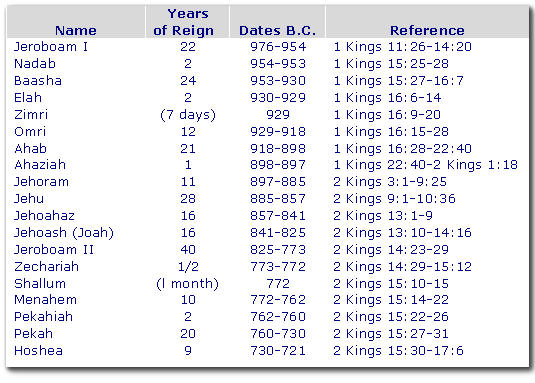
Kings of Judah
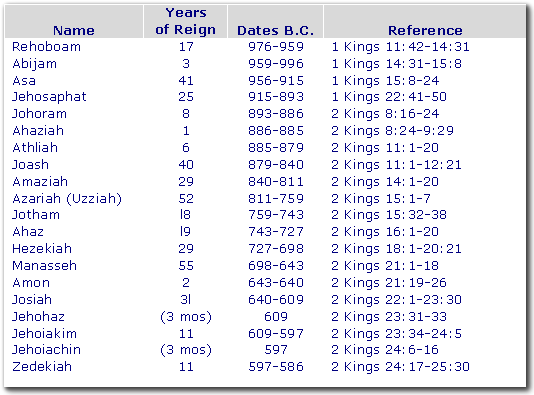
Summary Chart of the Divided Kingdom
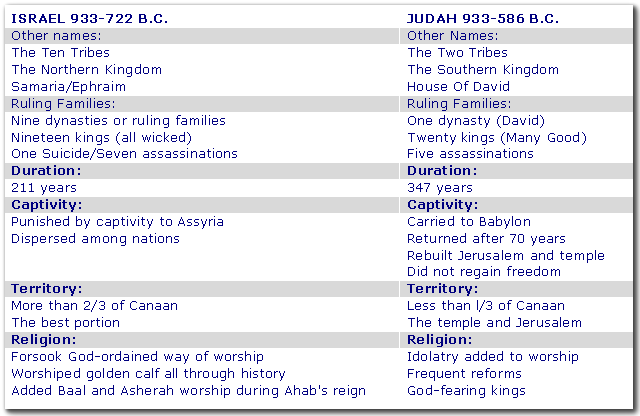
[Back to Top...]
Survey of the Books of 1 and 2 Chronicles
1 Chronicles
AUTHOR: Unknown. Possibly Ezra.
TO WHOM: Israel
PURPOSE: Record of the religious history of Judah.
KEY VERSE: 29:11— "Yours, O LORD, is the greatness and the power and the glory and the victory and the majesty, for all that is in the heavens and in the earth is yours. Yours is the kingdom, O LORD, and you are exalted as head above all."
LIFE AND MINISTRY PRINCIPLE: When God is exalted His people are blessed.
MAIN CHARACTERS: King David, Solomon
Outline
- Genealogies from Adam to David: 1:1-9:44
- From Adam to Jacob: 1:1-2:2
- From Jacob to David: 2:2-9:44
History of King David: 10:1-29:30
- The death of King Saul: 10:1-14
- Capture of Zion and David's heroes: 11:1-12:40
- David's prosperous reign: 13:1-22:1
- David's religious accomplishments: 22:2-29:30
[Back to Top...]
2 Chronicles
AUTHOR: Unknown. Possibly Ezra.
TO WHOM: Israel
PURPOSE: Record of the religious history of Judah.
KEY VERSE: 7:14— "if my people who are called by my name humble themselves, and pray and seek my face and turn from their wicked ways, then I will hear from heaven and will forgive their sin and heal their land."
LIFE AND MINISTRY PRINCIPLE: God's blessings come through humbling ourselves and seeking Him.
MAIN CHARACTERS: King Solomon and his successors from Rehoboam to Zedekiah (see the charts of the kings above).
Outline
- History of King Solomon: 1:1-9:31
- Solomon's wealth and wisdom: 1:1-17
- Solomon's building and dedication of the temple: 2:1-7:22
- Solomon's various activities: 8:1-9:28
- Solomon's death: 9:29-31
History of the kings of Judah: 10:1-36:23
- Kings from Rehoboam to Zedekiah: 10:1-36:21
[For detailed study of these kings, see the charts of the kings above.]
- The edict of Cyrus: 36:22-23
Further Study
Although there is much similar material in the books of 2 Samuel, the Kings and the Chronicles, each book is written to accomplish a specific purpose. For example, 2 Samuel and 1 and 2 Kings present the political history of both Israel and Judah. In 1 and 2 Chronicles, however, a detailed religious history of Judah only is presented.
2 Samuel and 1 and 2 Kings focus on the rulers and prophets of the period, while 1 and 2 Chronicles focus on the priests and the temple.
As you study these books in detail, look for the differing emphasis of the material which is repeated.
2 Chronicles is a book of revivals. Great revivals occurred under:
- Asa: 2 Chronicles 15
- Jehoshaphat: 2 Chronicles 20
- Joash: 2 Chronicles 23-24
- Hezekiah: 2 Chronicles 29-31
- Josiah: 2 Chronicles 35
Key words in the Chronicles to mark in your Bible:
- house
- ark
- covenant
- cry (cried)
- seek (sought)
- heart
- pray (prayer, prayed)
- prophet(s)
You can also learn many lessons about prayer and seeking God in these two books. Review what you learn from marking the key words. Study especially 2 Chronicles 6.
[Back to Top...]
Survey of the Book of Ezra
AUTHOR: Ezra
TO WHOM: Israel
PURPOSE: Tells of the return of God's people from exile in Babylon and the rebuilding of the temple in Jerusalem.
KEY VERSE: 6:16— "And the people of Israel, the priests and the Levites, and the rest of the returned exiles, celebrated the dedication of this house of God with joy."
LIFE AND MINISTRY PRINCIPLE: Return and restoration are basic principles of repentance.
MAIN CHARACTERS: Ezra, Jeshua, Zerubbabel, Cyrus, Haggai, Zechariah, Artaxerxes
Outline
- Restoration under Zerubbabel: 1:1-6:22
- First return of exiles: 1:1-2:70
- Edict of Cyrus: 1:1-11
- List of exiles: 2:1-70
- Restoration of public worship: 3:1-6:22
- Rebuilding of the temple: 3:1-6:15
- Dedication of the temple: 6:16-22
Reforms under Ezra: 7:1-10:44
- Second Return of Exiles: 7:1-8:36
- Ezra's background and preparation: 7:1-10
- The letter of Artaxerxes: 7:11-26
- The response of Ezra: 7:27-28
- Correction of social evils: 9:1-10:44
- God's people compromising: 9:1-2
- Ezra's supplication: 9:3-15
- Conviction settles on the people: 10:1-8
- Confession and repentance: 10:9-16
- The list of offenders: 10:18-44
Further Study
Read Psalm 137. It records the sorrow of God's people as they made the trip from Jerusalem to captivity in Babylon. Next, read Psalm 126, which describes their joy on the return to Jerusalem from captivity.
The divided kingdoms of Israel and Judah were both taken captive by enemies. Israel was taken captive by Assyria in 721 B.C. and Judah was taken captive by Babylon in 606 B.C. God's people returning to Jerusalem from captivity took place as follows:
- 536 B.C. Zerubbabel with 42,360 Jews, 7,337 servants, 200 singers, 736 horses, 245 mules, 435 camels, 6,720 asses, and 5,400 vessels of gold and silver.
- 457 B.C. Ezra with 1,754 men, 100 talents of gold, and 750 talents of silver. The record does not show whether women and children were in this group of returning exiles.
- 444 B.C. Nehemiah, with an army escort, to rebuild and fortify Jerusalem.
There were three trips into Babylonian bondage. In Ezra, there are three journeys back to the Promised Land.
- Three trips into exile in Babylon:
- In the days of Daniel: 606 B.C.
- In the days of Ezekiel: 597 B.C.
- In the days of King Zedekiah: 586 B.C.
Three trips back to freedom:
- Led by Zerubbabel and Joshua 538 B.C.
- Led by Ezra: 456 B.C.
- Led by Nehemiah: 446 B.C.
[Back to Top...]
Survey of the Book of Nehemiah
AUTHOR: Nehemiah1
TO WHOM: Israel
PURPOSE: Continuation of the history of Israel. Record the rebuilding of the walls of Jerusalem.
KEY VERSE: 6:3— "And I sent messengers to them, saying, 'I am doing a great work and I cannot come down. Why should the work stop while I leave it and come down to you?'"
LIFE AND MINISTRY PRINCIPLE: There is no opportunity without opposition. Faith without works is dead.
MAIN CHARACTERS: Nehemiah, Sanballat, Geshem, Gashmu, Shemiah, Tobiah, Hananiah, Ezra, Artaxerxes
Outline
- Introduction: 1:1-11
- Bad news from Jerusalem: 1:1-3
- Nehemiah's response: 1:4-11
Preparation for the task: 2:1-20
- With the King: 2:1-8
- With the governors: 2:9-10
- In Jerusalem: 2:11-15
- With the leaders of the people: 2:15-20
Restoration of the walls: 3:1-6:19
- List of builders and organization: 3:1-32
- External and internal opposition: 4-6:14
- External opposition: 2:19; 4:1-3,6,8; 5:14-19; 6:2,5-9
- Internal opposition: 3:5; 4:10-12; 5:1-19; 6:10-13
- The wall is finished: 6:15-19
Control and census: 7:1-73
- City controls established: 7:1-4
- Census of returning exiles: 7:5-73
Religious reforms by Ezra and Nehemiah: 8:1-13:31
- Reading of the law: 8:1-8:18
- Confession and prayer: 9:1-37
- Renewal of the covenant: 9:38-10:39
- List of residents: 11:1-12:26
- Dedication of the wall: 12:27-47
- Reforms of Nehemiah: 13:1-31
Further Study
A work for God will always be met by human and Satanic opposition, both internally and externally. As you study the book of Nehemiah, make a list of the various attacks of the enemy designed to stop the work of God.
Nehemiah's Top Ten Inspirational Slogans
- "The good hand of my God was upon me." (2:8)
- "Let us rise up and build." (2:18
- "The God of Heaven will prosper us." (2:20)
- "The people had a mind to work." (4:6)
- "Remember the Lord and fight." (4:14)
- "God shall fight for us." (4:20)
- "O God, strengthen my hands." (6:9)
- "This work was wrought of our God." (6:16)
- "The joy of the Lord is our strength." (8:10)
- "Remember, O My God." (13:29,31)
The gates in the wall around Jerusalem are a type of the Christian life. That means, although they were actual gates, they were also symbols of spiritual truth:
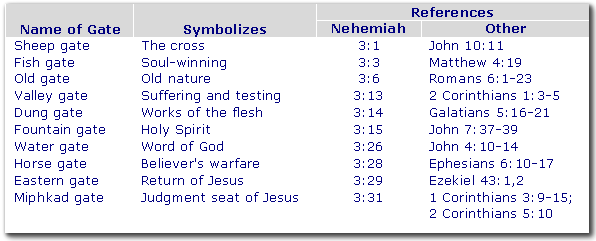
[Back to Top...]
Survey of the Book of Esther
AUTHOR: Unknown
TO WHOM: The Jews scattered throughout Persia.
PURPOSE: Continuation of history of Israel. Also to recount the providential care of God for His people.
KEY VERSE: 4:14— "For if you keep silent at this time, relief and deliverance will rise for the Jews from another place, but you and your father's house will perish. And who knows whether you have not come to the kingdom for such a time as this?"
LIFE AND MINISTRY PRINCIPLE: God meets the crises of life with human vessels whom He has prepared.
MAIN CHARACTERS: Esther, Vashti, Haman, Mordecai, Ahasuerus
Outline
- Introduction: 1:1-22
- The great feasts: 1:1-9
- A domestic problem: 1:10-12
- A royal commandment: 1:13-22
A new queen: 2:1-21
- The search for a queen: 2:1-4
- Esther enters the competition: 2:5-11
- Esther in the custody of Hegai: 2:8-11
- The women presented before the king: 2:12-14
- Esther selected as queen: 2:15-17
- Esther's secret: 2:19
Two men, two plots: 2:21-3:15
- The plot overthrown by Mordecai: 2:22-23
- The promotion and plot of Haman: 3:1-15
Despair and deliverance: 4:1-7:10
- Despair of the Jews: 4:1-3
- Despair of the Queen: 4:4-9
- A plan for deliverance: 4:10-5:14
- Mordecai honored: 6:1-14
- The feast of Esther: 7:1-6
- Haman punished: 7:7-10
The new kingdom order: 8:1-10:3
- New orders from the king: 8:1-14
- Mordecai honored: 8:15-17
- Deliverance of the Jews: 9:1-11
- House of Haman destroyed: 9:12-14
- The feast of Purim: 9:15-32
- Representation by Mordecai: 10:1-3
Further Study
The longest verse in the Bible is Esther 8:9. It contains 90 words in the King James version of the Bible.
"Then were the king's scribes called at that time in the third month, that is, the month Sivan, on the three and twentieth day thereof; and it was written according to all that Mordecai commanded unto the Jews, and to the lieutenants, and the deputies and rulers of the provinces which are from India unto Ethiopia, an hundred twenty and seven provinces, unto every province according to the writing thereof, and unto every people after their language, and to the Jews according to their writing, and according to their language."
Note the contrasts between Ruth and Esther:
- Ruth was a Gentile who lived among Jews.
- Esther was a Jew who lived among Gentiles.
- Ruth married a Jew.
- Esther married a Gentile.
- The outcome of both stories was determined through a midnight meeting:
Haman in the book of Esther can also be considered a type of Satan:
- Above all princes: 3:1
- Full of wrath: 3:5
- Full of scorn: 3:6
- Destroyer: 3:6
- Enemy: 3:10
- Materialistic: 3:8,9,11; 4:7
- Perplexes: 3:15
- Seeks out prey: 3:13
- None escape from him: 4:13
- Full of indignation for others: 5:9
- Proud: 5:11-12; 6:6-9
- Petty: 5:13; 6:12
- A schemer and deceitful: 3:1-15; 5:14; 6:4
- An adversary and enemy: 7:6
- Immoral: 7:8
- Wicked devises: 9:25
- Fears before the King: 7:6
- Falls before the people of God: 6:13
[Back to Top...]
 Questions/Comments? Questions/Comments?
If you have a question or comment, please
send us an email. If this lesson is one in a
series of lessons, please write the lesson name.
--------------------------------
1 Nehemiah — Many theologians believe Ezra wrote the book of Nehemiah. The reason for such thinking is that the books of Ezra and Nehemiah were combined into one book in the original scrolls.
 
|



 The next group of Old Testament books we will survey are the books of history. These include:
The next group of Old Testament books we will survey are the books of history. These include:





